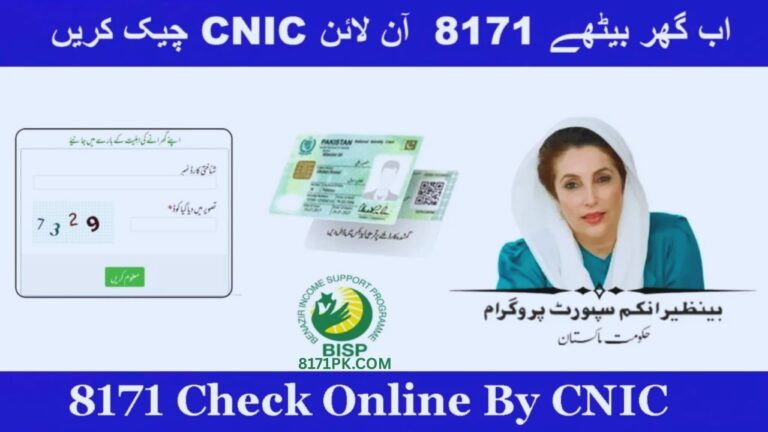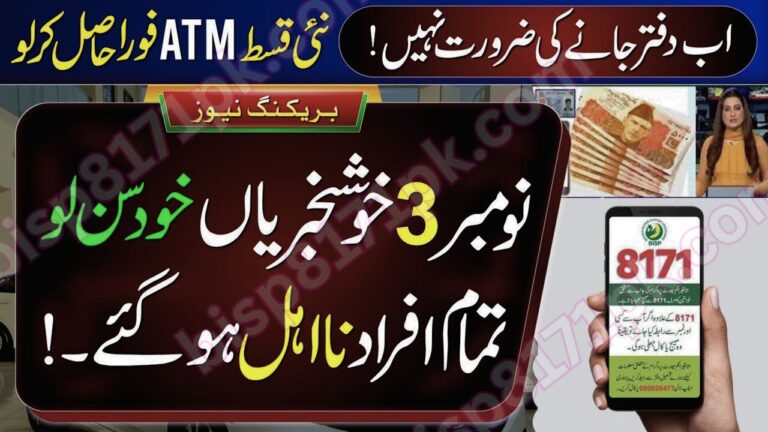BISP 8171 New Update 2025: Decode the Rs. 27,500 Payment, Dynamic Survey Deadline, and the Future of Digital Wallets
The Benazir Income Support Program (BISP) is once again making headlines across Pakistan with the announcement of a massive new installment. For millions of beneficiaries, the news that the standard Rs. 13,500 payment could potentially jump to Rs. 27,500 is a beacon of hope, but it also raises immediate questions about eligibility, status, and the new rules governing the disbursement.
As Pakistan’s largest social safety net, BISP is committed to refining its system to ensure that aid reaches only the most deserving families. This commitment has ushered in a new era defined by the Dynamic Survey, stricter eligibility monitoring, and a major technological leap toward Digital Wallets.
This comprehensive, human-tuned guide cuts through the rumors to provide you with the confirmed facts. We will explain how you can receive the BISP Double Installment, why your account might show a zero balance, and the critical steps you must take right now at the 8171 Web Portal and your local Tehsil Office to secure your financial future for the next three years.
I. The Double Installment Phenomenon: How to Get Rs. 27,500
The sudden projection of the BISP payment to nearly double its standard amount has caused excitement and confusion in equal measure. To be clear, the Rs. 27,500 figure is not a new, increased single installment; it represents the clearance of pending payments alongside the current installment.
The Mechanics of the Double Payment
The BISP system often holds payments for beneficiaries who are otherwise eligible but face temporary hurdles. This double payment typically occurs under two major scenarios:
1. Clearance of a Single Pending Installment
The current standard Kafalat installment is approximately Rs. 13,500. If you were eligible for the previous payment cycle but did not receive the funds, your balance was recorded as pending.
- Scenario: A beneficiary who was due Rs. 13,500 in the last cycle, but could not collect it, and is now due the current Rs. 13,500 installment.
- Result: The BISP system is now releasing both the pending installment (Rs. 13,500) and the current installment (Rs. 13,500) simultaneously, resulting in a total payment of Rs. 27,000 (or up to Rs. 27,500).
2. Causes for Installment Blocks
If you are an eligible beneficiary and were expecting a double payment but only received the single Rs. 13,500, it’s crucial to understand why your previous installment might have been blocked:
- Expired CNIC: If your National Identity Card (CNIC) was expired during the previous payment window, the system automatically blocked the transaction.
- Biometric Verification Failure: Many recipients, especially housewives, face difficulty with fingerprint recognition at the payment device. If the biometric scanner fails to identify you, the payment is withheld.
- Administrative Hold: In some cases, payments are temporarily halted while the BISP system runs automated eligibility checks against external databases.
Action Point: If you receive a double installment, it confirms that you had a previous pending amount. You must proactively fix the underlying issue (e.g., renew your CNIC or update fingerprints at NADRA) to prevent future blocks.
II. The Crisis of Zero Balance: Why 90% of Payments Are Halted
The most pressing concern currently faced by millions of families is the shocking discovery of a zero balance when checking their BISP accounts, despite believing they are still eligible. The video highlights a grim statistic: 90% of those querying a zero balance have been declared ineligible.
The core reason for this mass exclusion is the failure to comply with the Dynamic Survey.
The Absolute Necessity of the Dynamic Survey
The Dynamic Survey (also known as the BISP Survey or NSER Survey update) is not an option; it is a mandatory requirement for every BISP recipient. Its purpose is to regularly update the socioeconomic profile of beneficiary families to ensure they still fall below the Poverty Means Test (PMT) score threshold.
- The Consequence of Inaction: The video clearly states that women who are currently seeing zero balance or whose payments have suddenly stopped are primarily those who failed to complete the Dynamic Survey on time.
- Systemic Suspension: The BISP system automatically suspends payments for individuals who miss the survey deadline, regardless of their past eligibility.
How to Confirm Your Ineligibility Status
If you were receiving payments and they suddenly stopped, you must immediately confirm your status to understand your next course of action.
1. Use the 8171 Web Portal (The First Step)
The simplest and quickest way to check your BISP status is via the official 8171 Web Portal.
- Process: Visit the official BISP website, enter your 13-digit CNIC number, complete the CAPTCHA code, and submit.
- Outcome 1 (Ineligible): If the portal informs you that you are ineligible and provides a past date for a new survey, this confirms your exclusion. Your payments have been permanently suspended, and you must follow the re-eligibility steps below.
- Outcome 2 (Eligible but Pending): If the portal confirms you are eligible but you haven’t received your current installment, your payment is likely held up due to administrative issues or a previous payment block. You must visit the retailer shop to withdraw.
III. Your Roadmap to Re-Eligibility: Updating the Dynamic Survey
For those declared ineligible solely due to non-compliance (missing the survey), there is a crucial window of opportunity to re-enter the BISP program. This requires immediate action at the grassroots level.
Step 1: Gather Mandatory Documentation
Before visiting the BISP Tehsil Office, ensure you have the following original and photocopy documents ready. Incomplete documentation is the leading cause of rejection during the update process.
- CNICs (Original & Copy): Both the beneficiary (wife) and the husband’s valid CNICs.
- Children’s B-Forms: Original and copies of the children’s B-Forms/CNICs.
- Registered Mobile Number: The original mobile number registered in the beneficiary’s name.
- Utility Bills: Recent copies of utility bills (Gas or Electricity). These are used to verify your current living standard and address.
Step 2: Visit the BISP Tehsil Office
Take all the documents and proceed directly to the nearest BISP Tehsil Office.
- The Procedure: Inform the BISP official that you were an eligible recipient whose payments were suspended due to the Dynamic Survey deadline. They will initiate one of two processes:
- Dynamic Survey Update: If your survey data is very old, you will complete the full Dynamic Survey process.
- Roster Update: If your last survey was relatively recent, they might simply update your roster to show compliance.
- Immediate Action for the Deserving: The video strongly emphasizes that this re-survey option is primarily for those who are genuine hakdars (rightful recipients). Individuals who do not meet the poverty criteria (e.g., those with high PMT scores or significant assets) will remain ineligible, even after completing the new survey.
Step 3: Wait for Re-Confirmation and the Three-Year Guarantee
Once your data is updated, it is fed back into the NADRA system for re-assessment.
- The Reward: Families who successfully update their Dynamic Survey and remain within the PMT score limits (below 32) are now selected for the program with a confirmed three-year eligibility period.
- Continuous Support: This three-year guarantee means you can expect continuous Kafalat payments and Educational Stipends for your children without fear of sudden suspension, provided your financial status doesn’t drastically change.
IV. The Evolution of Payment: From Camp Sites to Digital Wallets
BISP is undergoing a critical transition in how payments are distributed, moving towards a modern, transparent, and convenient system that reduces friction for beneficiaries.
The Immediate Shift: Retailer Shops
Previously, the BISP used designated Camp Sites or large centers for payments. While functional, these sites often led to long queues, security issues, and difficulties for the elderly or disabled.
- New Rule: BISP has now largely converted the payment process to authorized Retailer Shops.
- Action: If you are due a payment (either the current single installment or the Rs. 27,500 double installment), you must now go to a designated BISP Retailer Shop rather than a Camp Site.
The Future: Digital Wallets and BISP SIMs
The most significant upcoming change is the move toward digital payments, which will eventually eliminate the need for both camps and retailer shops.
- The Promise: BISP will soon be distributing new Digital Wallets and BISP SIM cards to beneficiaries.
- Benefits:
- Convenience: Beneficiaries can access funds anytime, anywhere, reducing travel time and costs.
- Security: Payments are secured directly through bank/mobile accounts.
- Transparency: Reduces the risk of retailer deductions or corruption.
- Timeline: The process of opening these digital accounts and distributing the SIMs is expected to commence within the current month. BISP authorities and partnered financial institutions are currently finalizing the procedure for beneficiaries to open and operate their new Digital Wallets.
V. Troubleshooting and Maximizing Your BISP Entitlement
Receiving your entitled payment smoothly requires attention to administrative details and smart withdrawal habits.
1. Handling Payment Retrieval Issues
The video highlights two common administrative issues that prevent timely withdrawals:
- Biometric Failure: The inability to successfully scan fingerprints is a frequent problem. Before attempting to withdraw, ensure your fingers are clean. If the problem persists across multiple attempts, you must visit the nearest NADRA office to update your biometric data.
- Expired CNIC: The system will not process any BISP transaction against an expired CNIC. Ensure your card is always current by visiting NADRA.
2. Proactive Balance Checking (Avoid Losing Funds)
To ensure you receive the full amount, especially the double installment of Rs. 27,500, a key piece of advice is provided:
Always check your full balance before attempting a withdrawal.
- Why it Matters: If your previous installment was blocked but later released, the retailer may only inform you about the current installment. By asking the device operator to check the full balance against your CNIC, you confirm if the double amount is available.
- Warning: Funds that were never released (i.e., blocked before they were credited to your account) because you were declared ineligible during that cycle may be forfeited. However, funds that were released but not withdrawn due to technical issues are still available to you and will contribute to the double installment.
3. Securing Educational Stipends
The BISP Kafalat program is often supplemented by the Educational Stipends program for school-going children.
- Ensure Enrollment: If you are a BISP beneficiary, make sure every school-age child in your household is enrolled in the stipends program.
- Timely Payments: While the video focuses on the Kafalat payment, the stipends are also crucial and ensure continuous financial support tied to education.
VI. BISP’s Strategic Vision and Accountability (The Welfare Philosophy)
The stringent rules and digital transformation reflect BISP’s strategic shift from simple poverty relief to a mechanism for social mobility and government accountability.
The Role of PMT Score and Exclusion
The PMT (Poverty Means Test) score is the core metric used by BISP. It is continuously calculated based on the Dynamic Survey data. The government’s priority is to reduce the overall poverty rate, and its system is designed to identify and exclude families whose circumstances have improved.
By linking eligibility to external indicators—such as CNIC validity, utility bill usage, and foreign travel history (though not explicitly mentioned in this video, BISP regularly cross-checks these factors)—the program minimizes misuse and ensures that every rupee of aid goes to those most in need.
Anticipation for 2026 and Beyond
With the implementation of the Digital Wallet system and the three-year guarantee, BISP aims to:
- Reduce Fraud: Digitalization minimizes opportunities for corruption and unauthorized deductions by middlemen.
- Enhance Service Delivery: Direct bank transfers offer greater dignity and accessibility for recipients.
- Future Payment Increases: By operating with greater efficiency and transparency, the program becomes more sustainable, paving the way for future increases in the base installment amount, which are often tied to inflation and budget approvals.
VII. Conclusion: Your Call to Immediate Action
The BISP 8171 program is operating under a strict yet rewarding framework in 2025. The opportunity to receive the Rs. 27,500 Double Installment is real for those with pending payments, but the risk of permanent exclusion is equally high for those who ignore the new compliance requirements.
To secure your current and future BISP entitlement:
- Immediate Check: Use the 8171 Web Portal to confirm your status. If you see a zero balance or have not received the current installment, assume you are on the ineligible list.
- Act Now on the Dynamic Survey: If you missed the deadline, visit your nearest BISP Tehsil Office immediately with all required documents to update your survey or roster. This is your only lifeline for re-inclusion.
- Prepare for Digital: Stay alert for announcements regarding the BISP Digital Wallet and SIM distribution. This change will fundamentally revolutionize how you receive your aid.
Your entitlement under BISP is a crucial safety net. By understanding the new rules and acting decisively on the Dynamic Survey, you can ensure your family remains protected and benefits from the program’s evolution. Do not delay; secure your status today.








